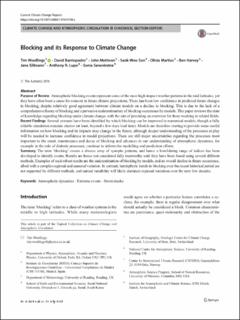Blocking and its Response to Climate Change
Woollings, Tim; Barriopedro, David E.; Methven, John; Son, Seok-Woo; Martius, Olivia; Harvey, Ben; Sillmann, Jana; Lupo, Anthony R.; Seneviratne, Sonia I.
Peer reviewed, Journal article
Published version
Permanent lenke
https://hdl.handle.net/11250/2753999Utgivelsesdato
2018Metadata
Vis full innførselSamlinger
- Journal articles [478]
Sammendrag
Purpose of Review Atmospheric blocking events represent some of the most high-impact weather patterns in the mid-latitudes, yet they have often been a cause for concern in future climate projections. There has been low confidence in predicted future changes in blocking, despite relatively good agreement between climate models on a decline in blocking. This is due to the lack of a comprehensive theory of blocking and a pervasive underestimation of blocking occurrence bymodels. This paper reviews the state of knowledge regarding blocking under climate change, with the aim of providing an overview for those working in related fields. Recent Findings Several avenues have been identified by which blocking can be improved in numerical models, though a fully reliable simulation remains elusive (at least, beyond a few days lead time). Models are therefore starting to provide some useful information on how blocking and its impacts may change in the future, although deeper understanding of the processes at play will be needed to increase confidence in model projections. There are still major uncertainties regarding the processes most important to the onset, maintenance and decay of blocking and advances in our understanding of atmospheric dynamics, for example in the role of diabatic processes, continue to inform the modelling and prediction efforts. Summary The term ‘blocking’ covers a diverse array of synoptic patterns, and hence a bewildering range of indices has been developed to identify events. Results are hence not considered fully trustworthy until they have been found using several different methods. Examples of such robust results are the underestimation of blocking by models, and an overall decline in future occurrence, albeit with a complex regional and seasonal variation. In contrast, hemispheric trends in blocking over the recent historical period are not supported by different methods, and natural variability will likely dominate regional variations over the next few decades. Blocking and its Response to Climate Change
